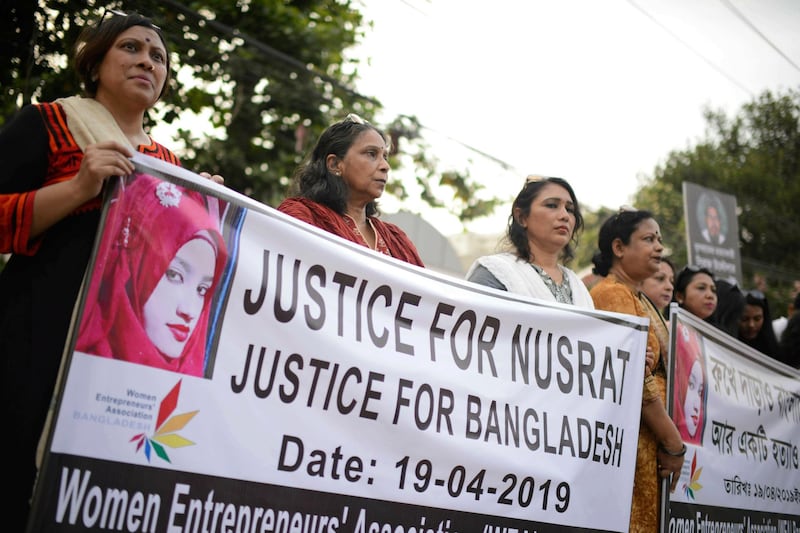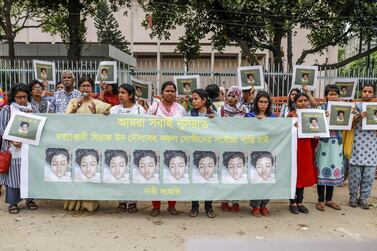Nusrat Jahan Rafi was just 19 years old when she was lured to the roof of her school, days after reporting her headteacher for sexual harassment. There, classmates and teachers poured kerosene on her and set her on fire. The teenager from Feni, a small town south of the Bangladesh capital Dhaka, died in April at the hands of the gang after she refused to withdraw her police complaint.
While those responsible for her murder have now been convicted, at every stage in this tragic tale, the treatment of Rafi was been found wanting. Instead of being assured a safe environment to recount her experiences, Rafi was filmed by a police officer, who released the footage online. She was told at the time it was "no big deal". Eleven days after the assault and filing of the complaint, Rafi returned to school to complete her exams. On that day, according to her final statement, a fellow female student led her to the roof of the school, saying one of her friends was being beaten up. When Rafi reached the rooftop, she was surrounded by the gang and pressured into withdrawing her statement against the headmaster. When she refused, they set her on fire.
As part of a plan orchestrated by the headmaster while under arrest, her classmates attempted to make it look like she had committed suicide. But Rafi escaped the rooftop and in an ambulance on the way to the hospital, her brother recorded her statement in a video in which she named several of her attackers and said she would fight the crime until her "last breath". Four days later, she died from 80 per cent burns.
The incident sparked outrage in Bangladesh. People took to the streets in protest and thousands attended her funeral. This month, the gang of 16, including the headteacher, were sentenced to death for their role. Rafi’s dying wish came true: she has been served justice, although she has paid the ultimate price for it.
This incident is not an isolated one. Sexual harassment is rife in Bangladesh and across south Asia. According to Action Aid, 84 per cent of women in Bangladesh have experienced derogatory comments or sexual advances in public. The women's rights group Mahila Parishad says at least three women are raped on average per day, yet only 2 per cent of women who face violence seek justice, according to Bangladesh Legal Aid and Services Trust. This makes Rafi’s bravery in challenging her attacker even more remarkable.
According to UN Women, 35 per cent of women globally have experienced physical or sexual violence. Rafi's case joins a long list of horrific crimes against women across the world that have ignited a much-needed global grassroots movement.
In December 2012, the world was horrified at the gang rape that took place on a bus in Delhi. Jyoti Singh, a 23-year-old student, was raped and tortured by six men, eventually dying from her injuries.
Also in 2012, a high school girl in Steubenville, Ohio, was sexually assaulted while unconscious by football players on the school team, who documented the crime on social media. Some members of the community blamed the girl and accused her for casting a negative light on the town and the football team. One CNN commentator even expressed sorrow for the "good students" who raped the girl and mourned the loss of their "promising futures". She was criticised for sympathising with the rapists rather than the victim, something that occurs in far too many instances of sexual assault.
And in August this year, college student Uyinene Mrwetyana, 19, was allegedly raped and bludgeoned to death by a postal worker when she went to collect a package from a post office in Cape Town.
These are just a few of the cases that have led to an ever-louder clamour of voices in the fight against sexual violence. In too many of these cases, the social structures that perpetrators hide behind and the prevailing social attitudes that protect them have much in common.
Men who target women are unconcerned with the consequences they are left to deal with. For some like Rafi, the consequences are fatal. For so many other victims, the psychological scars of assault are lifelong and damaging.
Sexual harassment affects women across classes, geographies and cultures. They affect livelihoods and relationships. The methods of control that assailants exert are often the same. Even the failure of appropriate responses – as with the police officer who filmed Rafi and released the footage – are mirrored worldwide. When sexual violence is allowed to proliferate through shame and stigma, whole societies suffer – not just the victims. Time and again we see that the price victims pay for speaking up is too high but the chance of being served justice remain low.
Whether or not you agree with the stringent sentence issued to Rafi's killers, one can only hope it will instigate change. The danger is that as long as those in authority prioritise perpetrators over victims, justice will never be done. To tackle this, we need a global response. The outrage at Rafi’s murder shows that the public demand for accountability for such horrors crosses political divides, boundaries of class and geography.
Nusrat Jahan Rafi had courage. We must not forget her legacy. In seeking justice for herself, she spoke for victims everywhere.
Shelina Janmohamed is the author of Love in a Headscarf and Generation M: Young Muslims Changing the World






